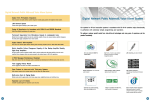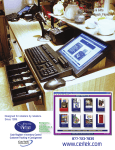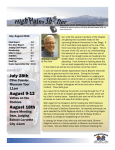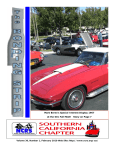Download PDF from NCRS - NCRS-RMC
Transcript
1 The Rocky Mountain Chapter-NCRS NATIONAL CORVETTE RESTORERS SOCIETY ROCKY MOUNTAIN CHAPTER March/April 2006 Issue 15& 16 INSIDE THIS ISSUE: CHAIRMANS MESSAGE MEMBERSHIP ACTIVITIES EDITORS NOTES JUDGING RETREAT RECAP 1971 CORVETTE EMISSIONS SYSTEM MERCHANDISE CLASSIFIED ADS 1 1-2 2 3 4 4-9 9 9-10 OFFICERS 10 CHAIRMANS MESSAGE By Ralph Ridge At our meeting in January, the membership expressed a desire to pursue sponsoring another NCRS Regional judging meet to be held in 2008. To that end, several members of your board held a special meeting to organize a proposal. Due to time constraints, we decided to submit a proposal for the meet to be held in Breckenridge since most of the legwork has already been accomplished for that venue. The proposal was submitted to NCRS National for consideration. We won’t know if we are successful in our bid until after the National Board meeting in San Antonio on March 25th. Another item discussed at the January meeting was whether or not the Rocky Mountain Chapter would be interested in submitting a proposal to sponsor a National Convention in our region in 2011. It was decided that this would be an appropriate subject for discussion at our annual meeting on March 18th. Due to the impact this decision will have on the entire membership, I encourage you to attend this meeting. Another important reason for attending the March meeting is the election of officers. A ballot has been sent out to all members, and I encourage you send in your proxy if you can’t attend the meeting in person. Lastly, but equally important, is the fact that our Chapter Judging meet is only a few weeks away on Sunday April 2nd at Bozarth Chevrolet on Havana Street. If you haven’t registered yet, please do so now. We need everyone there to help judge, and everyone MUST register. If you’re not bringing a car for judging, consider entering it in Sportsman. If nothing else, it’ll get you a priority parking spot. SAVE THE WAVE, Ralph MEMBERSHIP By Bob Montgomery This winter in Colorado has been very mild. It has been a tossup for me to either drive my Corvette or to get some of those winter projects out of the way! I have managed to do a little of both! The 2006 membership drive has completed and I have processed 108 renewals and 4 new memberships as of February 13th, 2006. Total membership stands at 112 members. 2 The Rocky Mountain Chapter - NCRS The newest members are: Earl Raymond of Keenesburg, CO with his 1967, 427/435 coupe. Lon Lemaster located in Mosman, New South Wales, Australia. Lon was introduced to the Chapter by Eckhard Pobuda. Dean Stevinson of Centennial, CO with his 1967, 427/435 roadster. I have published the 2006 NCRS RMC Membership directory as well as printing the 2006 membership cards. All members that had paid 2006 dues by January 31, 2006 are included in the directory. The directory and membership cards will be available at chapter functions beginning in February. Be sure to get your copy! Notice: Here is a correction for the membership directory that I missed before it went to the printer: Steve Beatty’s email address is [email protected] . How cool is that for an email address! The 2006 annual meeting and elections are scheduled for March 18th at Corvette City. I emailed the ballot to as many members as possible. Ballots will also be available at the annual meeting. Bob Montgomery [email protected] ACTIVITIES By Peter M. Gregory The Holiday Party on January 7th, 2006 was a great success! With approximately thirty two members signed in and their spouses or guests attending making a grand total of approximately sixty to sixty five people attending. The party was hosted by members Jan and Mike Bogan of Erie, CO. The beautiful home had a great garage area along with a living room area which was great for having our Rocky Mountain Chapter Board Meeting prior to the party. Also two classic Corvettes were found to be inside the garage. One being the hosts own ’63 Fuelie roadster and the other a guest Corvette a ’57 Fuelie. Another surprise awaited us, inside the attached airplane hangar to the house was again the hosts own 1960 Cessna 182 aircraft that had undergone extensive restoration and enhancements. A beautiful piece of aviation history! Great food and camaraderie was enjoyed by all who attended. The gift exchange was quite exciting and entertaining. Thanks to Lisa Racz-Gaddis for her help in co-coordinating the gift exchange. As you can see this was a party of all parties. Be apart of next year Rocky Mountain Chapter Holiday Party. See you at the party next year! The following is the next couple of month’s events. Please join us! March 18 – 11AM RMC Annual Meeting, Elections @ Corvette City April 2- 9AM Bosarth Chevrolet Chapter Judging Meet @ 3 The Rocky Mountain Chapter - NCRS Editors Notes By Dennis Dalton About 20 members braved the cold temperatures for the judging school at Corvette City Saturday January 18th. Dennis Kasmierzak conducted the school on C4 cars for Jim Lenartz. Jim left an excellent list of topics for Dennis and they can be viewed on the web site by clicking on JUDGING SCHOOL and then MORE INFO for the complete list. Below is a recap of the topics covered. If you have the blue C4 judging manual you need to request the “yellow” update sheets. Make sure you turn in the green registration sheet before the meet! In the future, Dennis hopes to have the sheets filled out by computer before the meet. Make sure the options list is present and in tact. It can be found under the console door between the seats. It is made of laminated paper glued in place and includes the vin #, all options and paint information. The new C4 manual has pictures but they must be viewed as “typical production” not the absolute final word. A judge needs to observe many cars from different areas of the country and record trends for accurate interpretation. There is an enhanced literature package with C4s, which may include a tape or CD, tire gauge, Rolex knock off watch (no kidding), etc. as well as the owner’s manual. Buy your own judging manual and take notes! There are extensive items to check in the OPS CHECK. Programming the radio, playing a CD or tape and optional seats that have air inflated lumbar supports are just a few of the items discussed. For example, when having your car judged in Texas, bring country music CD for the Ops Check! The word here is BE FAMILIAR with the car as much as possible. Don’t forget to register for the meet NOW. See you there! Dennis Dalton ED [email protected] 4 The Rocky Mountain Chapter - NCRS Judging Retreat Recap The 2006 NCRS Judging Retreat was held again February 9 – 13 at the Hilton DFW Lakes Executive Conference Center in Grapevine, Texas. My arrival on Thursday afternoon was mostly checking into my hotel for the weekend and seeing friends again from last year’s Judging Retreat and past NCRS Chapter and Regional Events. At 7PM a room was opened for event registration along with a cash bar for socializing. In attendance this year representing The Rocky Mountain Chapter was John Hilborn, Dave Talley and I. Early Friday morning found myself up for a continental breakfast provided by NCRS and then onto the classrooms for a full day of study of the Chevrolet Corvette. Classes were from 7AM till 6PM, with breaks and lunch time. Friday evening was free time and the three of us RMC members and my girlfriend Rosie who just happens to live in Dallas left the Hilton for a fine steak dinner at a nearby restaurant. Saturday morning up again early for the continental breakfast again provide by our host NCRS. Then onto our open forum of judging the invited NCRS cars in the Convention Center Hall. Many great Corvettes in this hall from a ’57 to several midyears to two ’69 L88’s and a ’71 LS6! I was assigned to a McLellan Award Car a ’75 L82 convertible. The day had breaks as well as a lunch time. Teams of two judged every section of your assigned car with usually the NCRS National Team Leader. There was much role playing between judges and the car owners along with the many “mentors” who were also NCRS Master Judges themselves. Again evening was open for activities with new and old friends. The next day I was up early checked out of my hotel and headed to DFW Airport and my American Airlines flight back home to Denver. It was another great weekend of ‘Great Cars & Great Friends”. My special thanks to my co-members from RMC for joining me, my instructors Marvin and Joan Burnett, National Team Leader 73-77 and Master Judges, John Burkheister Mentor and Master Judge, “Tony” the ’75 Corvette owner and the many speakers. Roy Sinor, National Judging Chairman for directing such a great Retreat! Oh my girlfriend Rosie for hauling us around and putting up with me talking about Corvettes ALL weekend! Peter M. Gregory National Corvette Restorers Society Rocky Mountain Chapter Activities Chairman NCRS # 4157 [email protected] 1971 Corvette Emissions System NCRS Driveline Article Submitted By: Jack Humphrey, Founder’s Award Requirement Date: 20 February 2005 In prior years, automobile pollution had become an issue of public awareness. California had ‘succeeded’ from the union by adopting its own state law requiring 1970 model year cars to meet a California-specific emissions profile. In Washington, lawmakers had been working for several years to establish a uniform, 50-State, emission standard. The legislation targeted 1971 model year cars for compliance. In the 1970 model year, the 1969 Corvette saw its production extended by ½-year with 1970 Corvettes not shipping until after January 1, 1970. Some say this introduction delay was a result of a 1969 strike at GM, but that’s doubtful: the strike didn’t affect any other 1970 5 The Rocky Mountain Chapter - NCRS Chevrolet models from rolling out on time. The debut of the 1971 Camaro line was also delayed, but insiders report this was the result of body panel tooling problems… A few speculate that 1970 Corvette introduction was intentionally delayed to gain as much time as possible to understand the impact of California’s newly adopted emissions laws. After all Corvette was the performance ‘flagship’ of the fleet with California buyers representing roughly 10% of sales. But, without supporting fact from behind closed management doors, this is simply speculation…. When the summer of 1970 arrived, all Chevrolet cars and trucks were ready to debut their new 1971 models. The traditional model year change over period was accomplished by all vehicles, including Corvette. GM vowed the 1971 models were READY to burn lead-free gasoline when it came on-stream! Significant design changes had been made for emission compliance. electrical input. In its energized state, the solenoid’s shaft extended to contact the carburetor’s throttle and INCREASE idle RPM. This gave engines two curb idle settings dictated by the CEC solenoid. Second, the solenoid had an internal vacuum passage. When the solenoid was energized, the solenoid’s two vacuum nipples were joined causing vacuum into the solenoid to be routed out of the solenoid. When the solenoid was not energized, the passageway between the two vacuum nipples was blocked to deny vacuum to advance spark timing. So, the CEC solenoid preformed two tasks at once: toggle curb idle RPM and pass or block vacuum. Figure 1, from the 1971 Chevrolet Chassis Service Manual (CSM), gives a system overview The new federal emissions standards were achieved with changes in basically three areas: (1) The vapor recovery system used on ’70 California cars was extended to all cars. (2) Engine compression ratios were lowered. (3) A new system called Combined Emissions Control (CEC) went into production. Consumers poorly understood the CEC system then and it’s not clearly understood by owners/restorers today. That’s the focus of this article. What is the CEC system and how does one properly restore a 1971 Corvette to make the system function? Combined Emissions Control System The heart of the CEC system is a unique solenoid that was mounted on a bracket attached to the carburetor. The CEC solenoid (GM 1114444) was unique because it provided two functions. First, the solenoid had a plunger shaft that would extend or contract based on The CEC solenoid was controlled by a pair of relays mounted on the engine compartment firewall directly in front of the driver. One of these solenoids (the reversing relay, GM 3990842) was ‘smart’ making it a miniature, pre-programmed, computer that decided when to fire the CEC solenoid. The other control relay (GM 3990843) was a delay device. It served to override the reversing relay and fire the CEC solenoid for a fixed period each time the engine was started. After the fixed time interval (about 15 seconds), the relay self-latched removing it from the circuit and relinquishing control to the reversing 6 The Rocky Mountain Chapter - NCRS relay until it was reset when the car stopped and the ignition was turned off. The reversing relay received inputs through the wiring harness from two other points. One input was a switch mounted on the transmission (manual or automatic) telling the relay when the vehicle was operating in high gear(s). The other input was a thermal switch mounted in the RH cylinder head. This switch had three positions to report engine temperature: (1) engine is cold and not yet up to normal operating temperature, (2) engine is within normal operating temperature range, and (3) engine is above normal operating temperature—overheating is a threat. How Does CEC Work? When the transmission is in low gear(s), it usually means the driver is accelerating to get up to cruising speed. In this case, spark timing is dominated by the distributor’s centrifugal advance mechanism. That means there’s really no need for the distributor’s vacuum advance to be active. The philosophy is valid unless you’re cruising in low gear for an extended period like in a parade! You only really need the distributor’s vacuum advance to be active when you’re at steady highway cruising speeds. So, the CEC solenoid kills two birds with one stone! It gives a more optimum burn profile during engine idle, doesn’t sacrifice low gear acceleration, restores vacuum controlled spark advance for high gear highway cruising, and reduces unburned HC emissions during high gear compression braking. The concepts underlying the CEC system were pretty simple. First, lowering an engine’s compression ratio reduces the amount of ‘blowby’ leaking around the piston rings and into the crankcase that form sulfated hydrocarbons. Also, you generate fewer exotic combustion byproducts (NOX, CO, ash, lead, Etc.) that would normally be a part of tail pipe emissions. The big tradeoff for a cleaner burn from a lower compression ratio is engine power loss. Once designers had the basic control mechanism in place (the CEC solenoid), they elaborated on its functionality with a few more ‘bells and whistles’ provided by the control relays. First, the CEC solenoid fires to boost idle RPM and feed the distributor’s vacuum advance for a fixed interval set by the Delay Relay. This was done to promote warm engine start, initial drivability. Next, when cruising the freeway and approaching an exit, the driver lets off on the accelerator to slow down. It’s the absolute change in engine RPM and carburetor throttle angle that dictate the amount of unburned hydrocarbons sucked from the intake manifold that go out the tail pipe. With a modest increase in engine RPM over normal curb idle made ONLY when the car is in high gear, another aspect of emissions (HC) is reduced. Second, the Reversing Relay is fed engine temperature information from the temperature switch mounted in the RH cylinder head. So long as the engine is below normal operating temperature, fire the CEC solenoid to speed the engine warm-up process and avoid ‘sluggish’ cold engine performance. When the engine is in normal thermal equilibrium, release the CEC solenoid and let it be controlled by the transmission switch alone In city driving, vehicles spend a healthy amount of time idling (stop signs, traffic lights, Etc.). There you want a low idle RPM and retarded timing to reduce tail pipe emissions. So, the CEC solenoid is de-energized and vacuum to the distributor’s advance mechanism is cutoff. This lets engine RPM fall as low as possible with a cleaner burning spark profile. Last, ‘grid lock’ was becoming an urban routine. Long periods of idle in hot summer traffic queues tax the cooling system (especially when A/C equipped). The coolant switch was given a third position (engine above normal temperature range) to fire the CEC solenoid again, modestly increase RPM and pull more air through the radiator to boost engine cooling. 7 The Rocky Mountain Chapter - NCRS On paper, the CEC system was a brilliant solution to a plurality of driving conditions and demands. Why was it a 1-year only feature? Why is it hard to understand/restore? The Documentation ‘Opps’ If you own a 1971 Corvette, you might have studied the engine portion of the wiring diagram. With any degree of due diligence, you’ll find it’s WRONG! Further study will lead you to conclude that what Chevrolet put in print is basically the 1970 engine wiring diagram without information to support the CEC electrical components that actually shipped on 1971 cars… Further, AIM pages showing the emissions components appear ‘helter skelter’. UPC Section 12, Electrical, shows 1970 Transmission Controlled Spark (TCS) components still on the engine and being wired up. The CEC control relays are called out in UPC Section 7, Transmission, but the drawing is still labeled TCS versus CEC. This tells me the CEC system was a ‘last minute’ engineering breakthrough that was rushed to production without all supporting drawings having been properly revised to match! Last, while there is a section in the Chassis Service Manual (CSM) covering theory of operation for the CEC system, there is no tutorial on troubleshooting to support it. And, the engine wiring diagrams for all 1971 Chevrolet cars in the CSM are incorrect as they fail to document the CEC wiring interconnect. Wow! What’s a restorer to do? What the heck did dealership mechanics do? How can you properly service and maintain a vehicle if the supporting documentation is incorrect and incomplete? The Recovery Path! I had a devil of a time getting my 1971 Corvette back to its as-delivered configuration and function. I’m an electrical engineer and I spent hours/days in reverse engineering mode disassembling parts and trying to reconstruct how the system originally worked to restore it properly. I finally got there with some ‘backdoor’ help. I discovered what looks like a case of ‘dumping’. The 1971 CEC components continued in use through 1972, but they were only incorporated on 6-cylinder Chevrolet engines. However, the 1972 version of the CSM did provide troubleshooting charts for the CEC and I used those to get my 1971 Corvette up and running. Later, I uncovered other GM/Chevy documents that fill in the blanks and shed more light. At various swap meets I uncovered a full set of 1971 Chevrolet Service News flyers. I also found a Chevrolet Communication pamphlet (CC-70-10-11) titled 1971 Chevrolet Emission Control Systems that’s a pocket-sized booklet intended to ‘brief’ readers on the CEC. Also, I obtained two KEY publications: (1) Chevrolet Motor Division, 1971 New Product Information, (NPI-4-71), and (2) Chevrolet Motor Division, 1971 Combined Emissions Control System Training Program Booklet, (NPI5-71). These publications constitute the ‘Rosetta Stone’ for 1971 Corvette owners wanting to restore and troubleshoot their CEC system! Both give in-depth, hands-on, details of the CEC system with enough information for one skilled in the art to troubleshoot. More important, the first book supplements the CSM by giving the missing troubleshooting charts! Figures 2 and 3 provide that data. 8 The Rocky Mountain Chapter - NCRS The Debacle In my experience, I’ve yet to see a truly unmolested, unrestored, 1971 Corvette from the standpoint of its factory installed CEC emission system being intact. I’ve seen numerous approaches by prior owners/mechanics to ‘castrate’ the CEC system including key component removal and wholesale butchery of the engine wiring harness! But, the sleeping giant awoke in the May 1971 issue of Chevrolet Service News. It contained a full set of corrected engine wiring diagrams for each 1971 Chevrolet passenger car, including Corvette, to remedy the incorrect information in the 1971 Chassis Service Manual! Figure 4 is the corrected engine wiring diagram for your Corvette! My gut tells me these ‘hack’ jobs were done by people unfamiliar with the CEC system who were frustrated by the car’s loss of power that went hand in glove with the 1970 to 1971 model year change. They butchered these cars in a futile effort to recoup the performance profile of earlier 1969-70 Corvettes and vented their frustrations on the obviously new CEC components beneath the hood. Ridiculous! The CEC was only a window dress item—the real cause for loss of power was the engine with it’s reduced compression ratio. Further, I think this is the reason CEC was a 1year only system for Chevrolet V8 engines. The 1972 system essentially worked the same way as the 1-year only CEC. However, it returned to a discrete TCS solenoid mounted on the RH side of the intake manifold (pass/block vacuum to the distributor) and it used a nonvacuum controlling idle solenoid on the carburetor that simply increased or decreased curb idle. The standalone vacuum solenoid WAS part of the 1970 TCS system and these were the last of the high performance/high compression ratio V8 engines for Corvette It looks to me like the 1971 CEC system was an EXCELLENT design that provided cost reduction by combining two separate solenoid functions into a single component but its timing to market was poor (released in tandem with the engine’s drop in compression ratio) and CEC feature/functions weren’t well explained. 9 The Rocky Mountain Chapter - NCRS Conclusion There’s nothing wrong with having a functional CEC system on your 1971 Corvette. It doesn’t rob power or performance. However, if your car has been ‘castrated’ then you’ll probably need the information given here to properly restore it. Do me one favor though… Please don’t call with trivia questions. Questions like, “Where do I find this/that component of the CEC system?” or ask me to troubleshoot your car for you. All of the information you need is here when considered with what’s in the Assembly Instruction Manual (AIM) and the Chassis Service Manual (CSM). Jack Humphrey, NCRS 1700 25381 Ridge Way Golden, CO 80401 (303) 526-9410 [email protected] Rocky Mountain Corvette Ltd. Work Limited to Corvettes D.J. Kazmierzak Owner - Operator Phone: (303) 748-8235 P.O. Box 787 e-mail: [email protected] Indian Hills, CO 80454 e-mail: [email protected] For Sale Ad 3/01/06 1979 Chevrolet Corvette. VIN 1Z8789S432563. White with Red Leather Interior. 350ci, Auto, A/C, PS,PB,PW, AM/FM Stereo w/8-Track Aluminum Wheels and Cruise. All original, excellent condition, very well maintained. 53k documented miles. Owner history back to original date of purchase including Dealer Invoice. $12,900. Peter Gregory 303-805-2936 [email protected] MERCHANDISE By Bill Pearson MERCHANDISE – IN STOCK ITEM Golf Caps...Red, White, Gray, Maroon, Natural/Green, and Natural/Blue T- Shirts…Silk screen Front & Back Sweatshirts…Silk screen Front & Back Short Sleeved Polo...White, Red, Blue & Gray (RMC Embroidered) Long Sleeved Polo...Dark Gray & Blue (RMC Embroidered) Light Weight Polo…Short Sleeved (Teal ) Shop Coats…Gray (RMC Embroidered) Chambray Shirt (RMC Embroidered) RMC Embroidered Jacket (special order) Steamboat Hat Pins RMC Hat Pins Name Tags VISIT OUR WEB SITE at WWW.NCRSRMC.ORG Specializing in 63-67 Corvette Repairs Mechanical & Electrical Recommendations for Body & Paint repairs All work by appointment. House calls on request. If it doesn’t run I’ll come to it. PRICE $11.00 $10.00 $20.00 $30.00 $35.00 $20.00 $35.00 $30.00 $50.00 $1.00 $3.00 $5.00 Ad 1/01/06 For Sale 1978 corvette silver Ann. 4-speed, L-48 engine, black interior, 35,000 miles, Firm @ $22,500. Martin Egan at 307-632-5806 or e-mail - [email protected]_ (mailto:[email protected]) Ad 11/01/05 1999 C5 Corvette convertible, 6 speed Magnetic Red, saddle leather interior, tan top Z51, 12 CD remote changer, HUD, sport bucket seats dual zone temp control, good rubber, much more. Excellent condition. Call Ralph @ 303-660-8531 Asking $32,500.00 10 The Rocky Mountain Chapter - NCRS Ad 11/01/05 Two Goodyear Eagle GSC unidirectional tires - 25540ZR17. Very good tread remaining. $80 for the pair. Bill Barcus (303) 773-2633 Ad 11/01/05 1962 Corvette matching number Maroon with Black interior, engine, transmission & rear axle rebuilt. Good paint and interior. Third owner, 250hp/327 with 4 speed, serial #13307, $45,000. Call Martin Eagan at 307-632-5806 TREASURER [email protected] Term expires: 12/31/2006 ACTIVITIES [email protected] Term expires: 12/31/2007 MERCHANDISE [email protected] Term expires: 12/31/2006 MEMBERSHIP [email protected] Term expires: 12/31/2006 TECHNICAL ADVISOR [email protected] Appointed Position COMMUNICATIONS [email protected] Appointed position Steve Beatty (303) 523-9517 Peter Gregory (303) 805-2936 Bill Pearson (303) 652-3185 Bob Montgomery (303) 734-4649 Gary Steffens (303)762-8388 Bob Davis (303) 838-9529 CORVETTESCORVETTESCORVETTES We now have a new black z06 in stock. Also, I have a new 2005 red convertible, acouple of 06 vettes in stock and a red low miliage 2002 covertable. Mike Rowland Bosarth Chevrolet 303-775-2448 [email protected] Advertisers: At our last meeting it was decided to leave ads in for 3 issues (6 months). All ads will now have a date. Please relist ads if you still want them listed and I will date them. ED ROCKY MOUNTAIN CHAPTER OFFICERS CHAIRMAN [email protected] Term expires: 12/31/2006 VICE CHAIRMAN [email protected] Term expires: 12/31/2007 EDITOR [email protected] Term expires: 12/31/2007 JUDGING CHAIRMAN [email protected] Term expires: 12/31/2007 CHAPTER LIAISON [email protected] Appointed position SECRETARY [email protected] Term expires: 12/31/2006 Ralph Ridge (303) 660-8531 Dennis Kazmierzak (303) 697-8428 Dennis Dalton (719) 583-2565 Jim Lennartz (303) 674-0295 Kevin Bell (719) 495-3551 Rick Reiff (303) 766-2654 Membership in the NCRS is open to persons interested in the restoration, preservation and history of the Corvette produced by the Chevrolet Motor Division of General Motors Corporation from 1953 through 1982. NCRS is not affiliated with Chevrolet or General Motors. Membership in the Rocky Mountain Chapter of the NCRS is open to all members of the NCRS National organization. Dues are $30.00 for the first year, and are $20.00 per year for renewal. First year dues entitle the new member to a Chapter ball cap and membership nametag. Advertising in the Rocky Mountain Chapter Newsletter is free to all active members, for all Corvette related items or Corvettes for sale. Commercial advertising rates for the Newsletter are $15.00 for a business card, $25.00 for a ¼ page, $40.00 for a ½ page and $60.00 for a full page. All rates are quoted for 6 issues or oneyear printing. Contact the editor for further information. All editorial material can be sent to the editor. NCRS registered marks used in this publication are: NCRS Founders Award®, NCRS Master Judge Award®, NCRS Performance Verification Award®, NCRS Flight Award®, and NCRS Sportsman Award®, and are registered with the United States Department of Commerce and Trademark Office. The NCRS American Heritage AwardSM application is pending.














